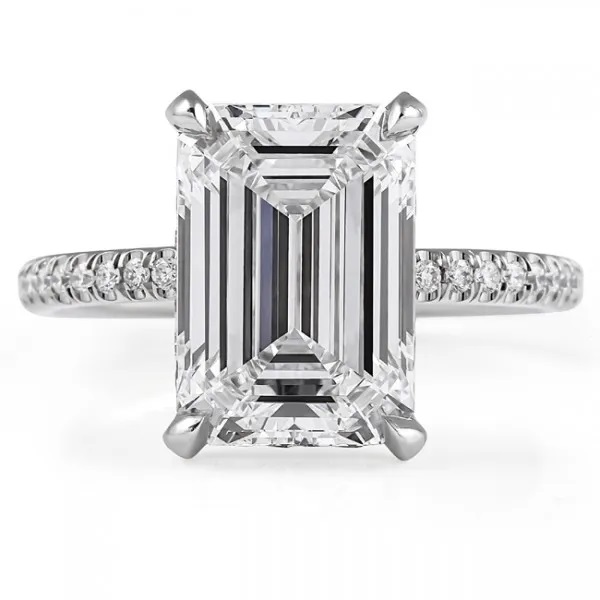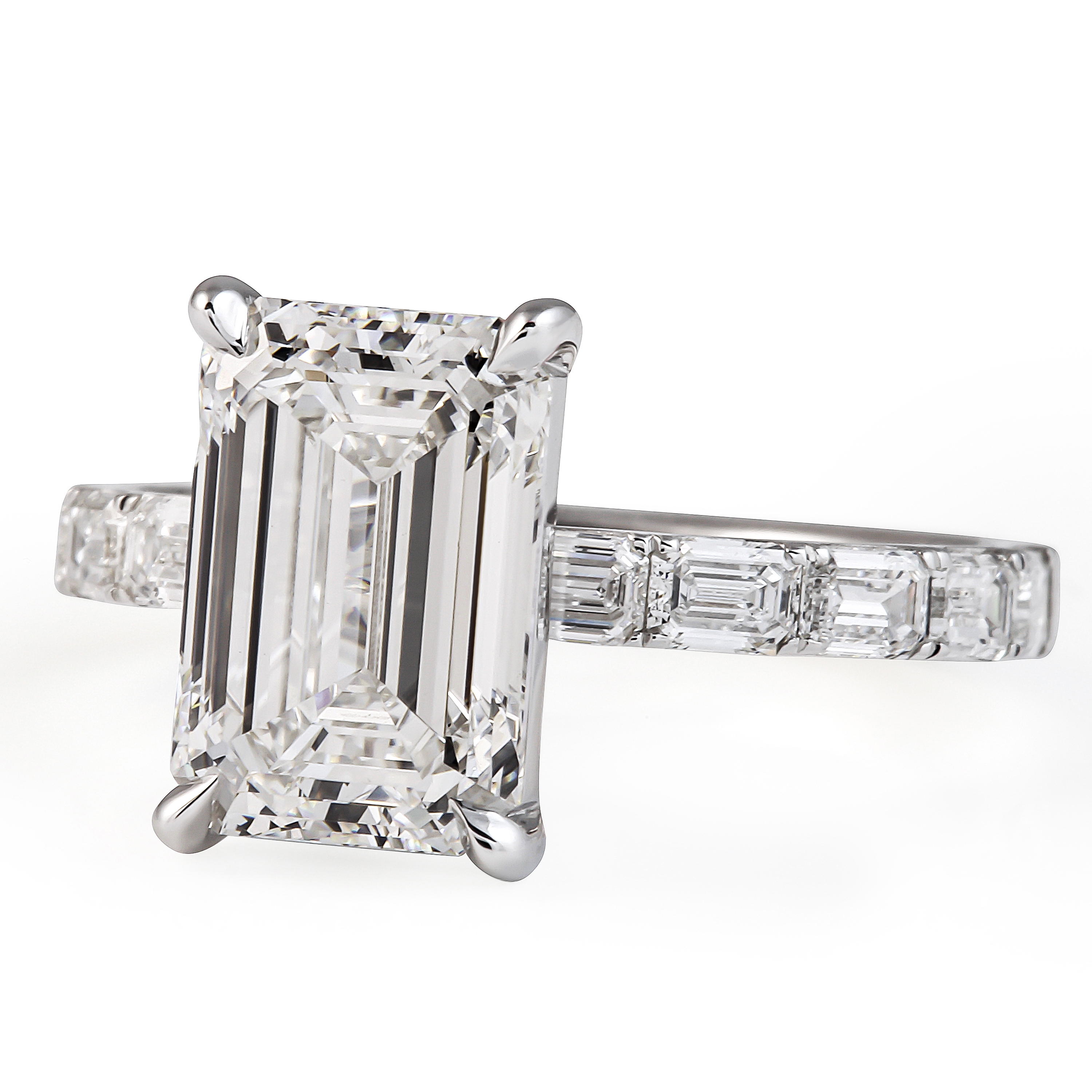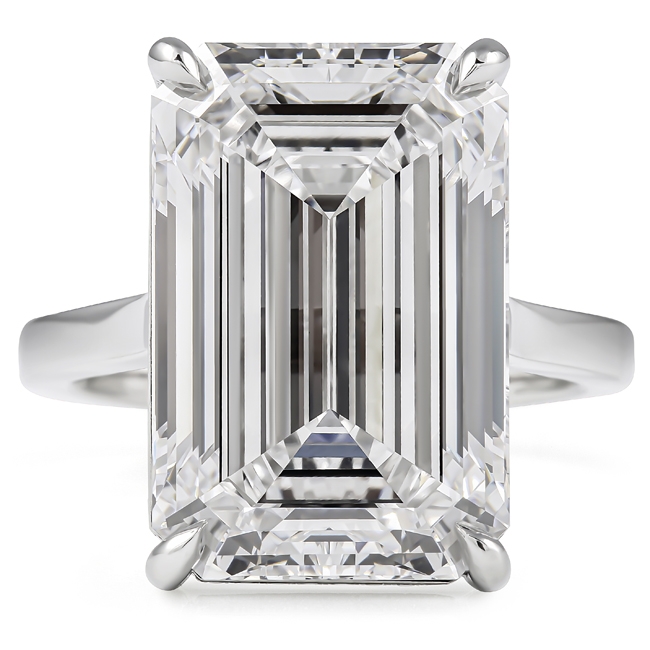Emerald Cut Lab Diamond Engagement Rings
Emerald cut engagement rings are both elegant and sophisticated with perfect symmetry. Emerald cut lab-grown engagement rings are the perfect blend of traditional elegance and modern technology.

View Some our Favorite Emerald Cut Lab Diamond Engagement Rings
Shop all Emerald Cut Lab Diamond Engagement RingsVisit our New York City Showroom or Shop with Us Remotely
Meet with us in-store at our New York City showroom or shop with us remotely to see more Emerald Cut Lab Diamond Engagement Rings.
Frequently Asked Questions
What should I look for when purchasing a lab-grown emerald-cut engagement ring?
An emerald cut diamond is known for its flashes of light instead of the sparkling brilliance that makes other fancy shapes popular. Because of the clear[er] appearance of emeralds, there is more flexibility when it comes to color; we suggest staying within the D-J range for the best quality. Clarity in emeralds is incredibly important; VS2 clarity and up is best for emeralds because there are fewer facets thus imperfections would be easier to detect to the naked eye. An eye-clean SI1 may exist but would be extremely rare. Finally, length-to-width ratio is very important for emeralds because they vary so drastically and will give you dramatically different appearances. For emeralds, ratios will typically vary from 1.3 for a more compact look all the way to 1.60 and above for a more elongated rectangular look.
Is a lab-grown emerald cut diamond ring high quality?
All natural and lab grown diamonds in our inventory are specially curated to be the best quality for our clients. At Lauren B, all of our lab-grown emerald cut diamond rings are of the highest quality we can offer.
How is a lab-grown diamond created?
There are two methods to create lab diamonds: High Pressure High Temperature (HPHT) and Chemical Vapor Deposition (CVD).HPHT was the first major method for creating lab-grown diamonds. It mimics the natural process of diamond formation in the span of a several weeks as opposed to several billion years. A diamond seed is placed into a special press with carbon. The area is until it reaches a temperature of around 1600 degrees Celsius, or about 2900 Fahrenheit. The chamber exerts pressure up to and over 870,000 pounds per square inch. Molten metal (typically from a source like graphite) in the chamber then dissolves the carbon source, and a diamond begins to form and build around the diamond seed.In CVD, a diamond seed is placed into a sealed vacuum chamber. After the chamber fills with carbon-heavy gas, like methane, it’s heated to a high temperature of around 1500 degrees Fahrenheit. The high temperatures convert the gas into plasma, which releases pieces of carbon. Those carbon pieces build upon the diamond seed originally placed in the chamber. Eventually, a full diamond forms after layer and layer of carbon pieces attach to the seed. The whole process produces incredible, chemically-pure diamonds free of most impurities. They don’t contain metal inclusions, either.You can read more about HPHT and CVD in our blog,An In-Depth Look at CVD vs. HPHT .
What’s the difference between lab-grown diamond engagement rings vs natural diamonds?
Natural diamonds form over millions of years under pressure from the Earth’s crust, and are mined, cut, and polished to produce the brilliant stones you find in jewelry. Lab-grown diamonds undergo the same process, only instead of millions of years, they form in a few weeks via a high temperature or a chemical vapor process. The difference between a natural and lab-grown diamond is indistinguishable to the naked eye. They have the same chemical and physical attributes, but specially trained gemologists may be able to use a magnifying tool to indicate growth patterns or the presence of elements that would help distinguish one from the other. However, the most trusted method is to use a testing machine. Both types can have inclusions, or tiny flaws, but have identical hardness.
Are lab-grown diamonds as durable as natural ones?
Natural and lab created diamonds have the exact same chemical composition. Because of this, lab diamonds are also just as durable as natural diamonds meaning they are the hardest, most durable gemstone on the Mohs scale.
Are lab-grown diamonds GIA-certified?
Not all lab-grown diamonds are GIA certified. However, all lab-grown diamonds at Lauren B are GIA certified! Browse our inventory of GIA Graded lab diamonds.
Are step-cut trapezoids more commonly paired with emerald-cut center stones?
Step cuts trapezoids have the same linear faceting pattern as an emerald cut or asscher cut which allows you to easily see within the stone. For the most part, they are most commonly paired with an emerald or asscher cut center-stone because of their seamless transition from stone to band.
Does a cathedral setting suit an emerald cut lab-created diamond?
The cathedral setting's structure includes arches that extend from the shank to the center stone. Think of this setting as a raised platform to showcase a diamond's magnificence. Plain arches are an excellent choice for individuals who prefer a minimalistic design. Pave diamonds accentuate the height and regalness of the cathedral setting. The emerald cut diamond is an elegant shape that complements an elegant setting. The curved arches provide interesting visual contrast against the emerald cut's elongated, octagonal shape. The raised profile makes an emerald cut's luster and hall of mirrors effect stand out even more.
















